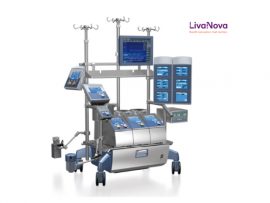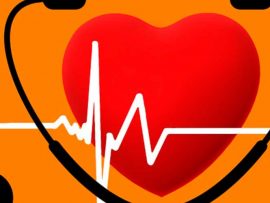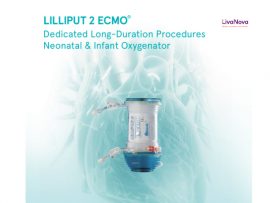Physicians often place patients on extracorporeal membrane oxygenation (ECMO) support because they expect them either to recover with additional support or to become candidates for transplant or mechanical support. If..
Read MoreAbstract Extracorporeal Membrane Oxygenation (ECMO) has become an essential lifesaving intervention for individuals with severe cardiovascular and respiratory failure. Its application is expanding across several therapeutic contexts, surpassing conventional indications...
Read MoreAbstract Extracorporeal membrane oxygenation (ECMO) is a life-saving intervention for patients with circulatory and/or pulmonary failure; however, the rate of complications remains high. ECMO induces systemic inflammation, which may activate..
Read MoreAbstract Burn patients face cardiopulmonary failure risks, with recent observational studies suggesting promising outcomes for extracorporeal membrane oxygenation (ECMO). However, the effectiveness and long-term survival remain unclear. Our study aims..
Read MoreAbstract Nitric oxide (NO) can be safely delivered through the sweep gas to the oxygenator of an extracorporeal membrane oxygenation (ECMO) circuit. It has theoretical benefits such as preventing platelet..
Read MoreAbstract Introduction A cross-sectional survey GENERATE (GEospatial aNalysis of ExtRacorporeal membrane oxygenATion in Europe) initiated on behalf of the European chapter of the Extracorporeal Life Support Organization (EuroELSO), aims to..
Read MoreAbstract Patients with refractory respiratory and cardiac failure may present to noncardiac surgery centers. Prior studies have demonstrated that acute care surgeons, intensivists, and emergency medicine physicians can safely cannulate..
Read MoreAbstract Purpose: This study reports on survival and health related quality of life (HRQOL) after extracorporeal membrane oxygenation (ECMO) treatment and the associated costs in the first year. Materials and..
Read MoreAbstract Purpose of review Surgery is an important option to consider in patients with massive and submassive pulmonary emboli. Earlier intervention, better patient selection, improved surgical techniques and the use of..
Read MoreAbstract Introduction This study aims to determine the oxygenator impact on alterations of peramivir (PRV) in a contemporary neonatal/pediatric (1/4-inch) and adolescent/adult (3/8-inch) extra-corporeal membrane oxygenation (ECMO) circuit including the..
Read MoreAbstract In late 2020, during the second wave of COVID-19 in Germany, we started using the MobyBox, which is a novel fully pneumatically driven ECMO device, on a regular basis..
Read MoreAbstract Introduction Extracorporeal membrane oxygenation (ECMO)–associated hemolysis still represents a serious complication. The present study aimed to investigate those predictive factors, such as flow rates, the use of anticoagulants, and..
Read MoreAbstract Right heart failure (RHF) is a common, yet difficult to manage, complication of severe acute respiratory distress syndrome requiring extracorporeal membrane oxygenation (ECMO) that is associated with increased mortality. Reports..
Read MoreAbstract Introduction We performed in vitro experiments using whole human blood without anticoagulants to clarify the activity of anticoagulant proteins on membranes coated with acrylate-copolymer (ACP) with a hydrophilic blood-contacting layer compared..
Read MoreAbstract Postoperative acute respiratory distress syndrome (ARDS) following a general thoracic procedure is associated with high morbidity and mortality. Extracorporeal membrane oxygenation (ECMO) offers an alternate means of cardiopulmonary support in the..
Read MoreAbstract Background Report the incidence and results of peri-operative extracorporeal membrane oxygenation (ECMO) and intra-aortic balloon pump (IABP) of patients undergoing mitral valve surgery (MVS) through right mini-thoracotomy (RT) and..
Read MoreAbstract We describe the successful transplantation of a brain-dead donor supported by veno-arterial extracorporeal membrane oxygenation (VA-ECMO) after cardiac arrest secondary to pulmonary embolism. The donor was a 50-year-old female..
Read MoreAbstract Background Duration of invasive mechanical ventilation (IMV) prior to extracorporeal membrane oxygenation (ECMO) affects outcome in acute respiratory distress syndrome (ARDS). In coronavirus disease 2019 (COVID-19) related ARDS, the..
Read MoreAbstract Providing optimal support in patients with concomitant cardiac and pulmonary failure presents multiple challenges. We report a novel approach to central extracorporeal membrane oxygenation support utilizing a minimal access..
Read MoreAbstract Initial reports described a hypercoagulable state and an increased risk of thrombosis in patients who tested positive for SARS-CoV-2. Infected patients with severe acute respiratory distress syndrome in the setting of..
Read MoreAbstract COVID-19 has ravished the world, with secondary consequences that are not yet possible to estimate. WHO and the European Extracorporeal Life Support Organization (ELSO) recommended extracorporeal membrane oxygenation (ECMO)..
Read MoreAbstract Introduction (ECMO) can be life-saving, but suffers from in the circuit with associated risks of occlusion, and . The formation of thrombin is the key step to thrombus formation and two factors are..
Read MoreAbstract Cardiac arrest (CA) is a frequent cause of death and a major public health issue. To date, conventional cardiopulmonary resuscitation (CPR) is the only efficient method of resuscitation available..
Read MoreAbstract Extracorporeal lung support includes the risk of hemolysis due to suction pressures. Manufacturers measure the negative suction pressure across drainage cannulas for their products in vitro using water. Clinical experience suggests..
Read MoreAbstract Secondary mitral valve regurgitation is a frequent consequence of left ventricular dysfunction in patients with severe heart failure. The management of this disease can be challenging since it often..
Read MoreAbstract Objectives: To present the recommendations and consensus statements with supporting literature for plasma and platelet transfusions in critically ill neonates and children undergoing cardiac surgery with cardiopulmonary bypass or..
Read MoreAbstract Cessation of continuous analgesia and sedation in patients with acute respiratory distress syndrome (ARDS) receiving venovenous (VV) extracorporeal membrane oxygenation (ECMO) facilitates early extubation, family, patient and provider engagement, and mobility...
Read MoreAbstract Extracorporeal membrane oxygenation (ECMO) is a rescue treatment used in children and adults with reversible cardiorespiratory failure. The role of ECMO is not fully established in pediatric sepsis. In..
Read MoreAbstract This guideline describes the ECMO circuit for all patient populations. These guidelines describe safe practice based on extensive experience and are considered consensus guidelines. These guidelines are not intended..
Read MoreAbstract Objectives: Children receiving prolonged extracorporeal membrane oxygenation (ECMO) support may benefit from tracheostomy during ECMO by facilitating rehabilitation; however, the procedure carries risks, especially hemorrhagic complications. Knowledge of tracheostomy practices and outcomes of..
Read More
















